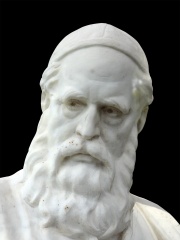
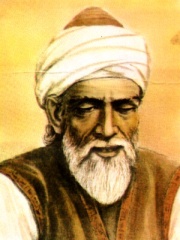
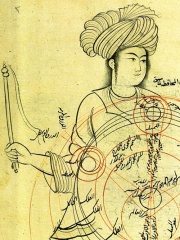

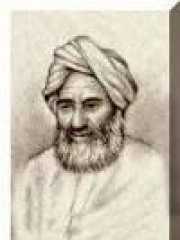

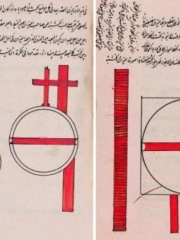

The Most Famous
MATHEMATICIANS from Iran
This page contains a list of the greatest Iranian Mathematicians. The pantheon dataset contains 1,004 Mathematicians, 17 of which were born in Iran. This makes Iran the birth place of the 13th most number of Mathematicians behind China, and India.
Top 10
The following people are considered by Pantheon to be the top 10 most legendary Iranian Mathematicians of all time. This list of famous Iranian Mathematicians is sorted by HPI (Historical Popularity Index), a metric that aggregates information on a biography's online popularity. Visit the rankings page to view the entire list of Iranian Mathematicians.

1. Omar Khayyam (1048 - 1131)
With an HPI of 86.69, Omar Khayyam is the most famous Iranian Mathematician. His biography has been translated into 115 different languages on wikipedia.
Ghiyāth al-Dīn Abū al-Fatḥ ʿUmar ibn Ibrāhīm Nīshābūrī (18 May 1048 – 4 December 1131) (Persian: غیاثالدین ابوالفتح عمر بن ابراهیم خیام نیشابورﻯ), commonly known as Omar Khayyam (عمر خیّام), was a Persian poet and polymath, known for his contributions to mathematics, astronomy, philosophy, and Persian literature. He was born in Nishapur, Iran and lived during the Seljuk era, around the time of the First Crusade. As a mathematician, he is most notable for his work on the classification and solution of cubic equations, where he provided a geometric formulation based on the intersection of conics. He also contributed to a deeper understanding of Euclid's parallel axiom. As an astronomer, he calculated the duration of the solar year with remarkable precision and accuracy, and designed the Jalali calendar, a solar calendar with a very precise 33-year intercalation cycle which provided the basis for the Persian calendar that is still in use after nearly a millennium. There is a tradition of attributing poetry to Omar Khayyam, written in the form of quatrains (rubāʿiyāt رباعیات). This poetry became widely known to the English-reading world in a translation by Edward FitzGerald (Rubaiyat of Omar Khayyam, 1859), which enjoyed great success in the Orientalism of the fin de siècle.

2. Abu al-Wafa' Buzjani (940 - 998)
With an HPI of 72.26, Abu al-Wafa' Buzjani is the 2nd most famous Iranian Mathematician. His biography has been translated into 49 different languages.
Abū al-Wafāʾ Muḥammad ibn Muḥammad ibn Yaḥyā ibn Ismāʿīl ibn al-ʿAbbās al-Būzjānī or Abū al-Wafā Būzhjānī (Persian: ابو الوفا بوژگانی, Arabic: ابو الوفا بوزجانی; 10 June 940 – 15 July 998) was a Persian mathematician and astronomer who worked in Baghdad. He made important innovations in spherical trigonometry, and his work on arithmetic for businessmen contains the first instance of using negative numbers in a medieval Islamic text. He is also credited with compiling the tables of sines and tangents at 15' intervals. He also introduced the secant and cosecant functions, as well studied the interrelations between the six trigonometric lines associated with an arc. His Almagest was widely read by medieval Arabic astronomers in the centuries after his death. He is known to have written several other books that have not survived.

3. Qutb al-Din al-Shirazi (1236 - 1311)
With an HPI of 67.04, Qutb al-Din al-Shirazi is the 3rd most famous Iranian Mathematician. His biography has been translated into 28 different languages.
Qotb al-Din Mahmoud b. Zia al-Din Mas'ud b. Mosleh Shirazi (Persian: قطبالدینْ محمود بن ضیاءالدینْ مسعود بن مصلح شیرازی; 1236–1311) was a 13th-century Persian polymath and poet who made contributions to astronomy, mathematics, medicine, physics, music theory, philosophy and Sufism.

4. Abu Nasr Mansur (960 - 1036)
With an HPI of 66.50, Abu Nasr Mansur is the 4th most famous Iranian Mathematician. His biography has been translated into 23 different languages.
Abū Naṣr Manṣūr ibn ʿAlī ibn ʿIrāq al-Jaʿdī (Persian: ابونصر منصور بن علی بن عراق جیلانی; c. 960 – 1036) was a Persian Muslim mathematician and astronomer. He is well known for his work with the spherical sine law. Abu Nasri Mansur was born in Gilan, Persia, to the ruling family of Khwarezm, the Afrighids. He was thus a prince within the political sphere. He was a student of Abu'l-Wafa and a teacher of and also an important colleague of the mathematician, Al-Biruni. Together, they were responsible for great discoveries in mathematics and dedicated many works to one another. Most of Abu Nasri's work focused on mathematics, but some of his writings were on astronomy. In mathematics, he had many important writings on trigonometry, which were developed from the writings of Ptolemy. He also preserved the writings of Menelaus of Alexandria and reworked many of the Greeks theorems. He died in the Ghaznavid Empire (modern-day Afghanistan) near the city of Ghazna.

5. Abū Sahl al-Qūhī (940 - 1000)
With an HPI of 66.26, Abū Sahl al-Qūhī is the 5th most famous Iranian Mathematician. Her biography has been translated into 23 different languages.
Abū Sahl Wayjan ibn Rustam al-Kūhī (al-Qūhī; Persian: ابوسهل بیژن کوهی Abusahl Bijan-e Koohi) was a Persian mathematician, physicist and astronomer. He was from Kuh (or Quh), an area in Tabaristan, Amol, and flourished in Baghdad in the 10th century. He is considered one of the greatest geometers, with many mathematical and astronomical writings ascribed to him. Al-Qūhī was the leader of the astronomers working in 988 at the observatory built by the Buwayhid amir Sharaf al-Dawla in Badhdad. He wrote a treatise on the astrolabe in which he solves a number of difficult geometric problems. In mathematics he devoted his attention to those Archimedean and Apollonian problems leading to equations higher than the second degree. He solved some of them and discussed the conditions of solvability. For example, he was able to solve the problem of inscribing an equilateral pentagon into a square, resulting in a fourth degree equation. He also wrote a treatise on the "perfect compass", a compass with one leg of variable length that allows users to draw any conic section: straight lines, circles, ellipses, parabolas and hyperbolas. It is likely that al-Qūhī invented the device. Like Aristotle, al-Qūhī proposed that the weight of bodies varies with their distance from the center of the Earth. The correspondence between al-Qūhī and Abu Ishaq al-Sabi, a high civil servant interested in mathematics, has been preserved.

6. Al-Khazini (1077 - 1155)
With an HPI of 65.89, Al-Khazini is the 6th most famous Iranian Mathematician. Her biography has been translated into 26 different languages.
Abū al-Fath Abd al-Rahman Mansūr al-Khāzini or simply al-Khāzini (Persian: أبوالفتح عبدالرحمن منصور الخازنی; flourished 1115–1130) was an astronomer, mechanician and physicist of Byzantine Greek origin who lived during the Seljuk Empire. His astronomical tables, written under the patronage of Sultan Sanjar (Zīj al-Sanjarī, 1115), are considered to be one of the major works in mathematical astronomy of the medieval period. He is considered to have been one of the greatest scientists of his era, among the greatest makers of scientific instruments of any time, and as "the physicist of all physicists". Al-Khazini is one of the few Islamic astronomers to be known for doing original observations. He provided the positions of fixed stars, and for oblique ascensions and time-equations for the latitude of Marv in which he was based. He also wrote extensively on various calendrical systems and on the various manipulations of the calendars. He also devised the world's most precise instrument for weighing ordinary objects, determining specific gravities, and even examining the composition of alloys. On the basis of his detailed description, it has been possible to reconstruct his complex mechanism, which he dubbed "The Comprehensive Balance". Modern study affirms his claim to its extraordinary accuracy of 1:60,000. Al-Khazini was the author of an encyclopedia on scales and water-balances called The Book of the Balance of Wisdom (Kitab Mizan al-Hikmah, 1121), which explored theories of density, specific gravities of metals, precious stones, and liquids, as well as principles of equilibrium. The book is thought to have been "one of the most sophisticated and advanced balances to be designed and manufactured in the medieval Islamic world", and "the most comprehensive work on [weighing] in the Middle Ages, from any cultural area".

7. Sharaf al-Dīn al-Ṭūsī (1135 - 1213)
With an HPI of 65.24, Sharaf al-Dīn al-Ṭūsī is the 7th most famous Iranian Mathematician. His biography has been translated into 22 different languages.
Sharaf al-Dīn al-Muẓaffar ibn Muḥammad ibn al-Muẓaffar al-Ṭūsī (Persian: شرفالدین مظفر بن محمد بن مظفر توسی; c. 1135 Tus, Iran – c. 1213 Iran) known more often as Sharaf al-Dīn al-Ṭūsī or Sharaf ad-Dīn aṭ-Ṭūsī, was an Iranian mathematician and astronomer of the Islamic Golden Age (during the Middle Ages).

8. Al-Karaji (953 - 1029)
With an HPI of 64.99, Al-Karaji is the 8th most famous Iranian Mathematician. His biography has been translated into 26 different languages.
Abū Bakr Muḥammad ibn al Ḥasan al-Karajī (Persian: ابو بکر محمد بن الحسن الکرجی; c. 953 – c. 1029) was a 10th-century Persian mathematician and engineer who flourished at Baghdad. He was born in Karaj, a city near Tehran. His three principal surviving works are mathematical: Al-Badi' fi'l-hisab (Wonderful on calculation), Al-Fakhri fi'l-jabr wa'l-muqabala (Glorious on algebra), and Al-Kafi fi'l-hisab (Sufficient on calculation).

9. Maryam Mirzakhani (1977 - 2017)
With an HPI of 61.82, Maryam Mirzakhani is the 9th most famous Iranian Mathematician. Her biography has been translated into 85 different languages.
Maryam Mirzakhani (Persian: مریم میرزاخانی, pronounced [mæɾˈjæm miːɾzɑːxɑːˈniː]; 12 May 1977 – 14 July 2017) was an Iranian mathematician and a professor of mathematics at Stanford University. Her research topics included Teichmüller theory, hyperbolic geometry, ergodic theory, and symplectic geometry. On 13 August 2014, Mirzakhani was honored with the Fields Medal, the most prestigious award in mathematics, becoming the first woman to win the prize, as well as the first Iranian. The award committee cited her work in "the dynamics and geometry of Riemann surfaces and their moduli spaces". Mirzakhani was considered a leading force in the fields of hyperbolic geometry, topology and dynamics. Throughout her career, she achieved milestones that cemented her reputation as one of the greatest mathematicians of her time, such as the "magic wand theorem", which tied together fields such as dynamical systems, geometry, and topology. After completing her PhD at Harvard University in 2004, Mirzakhani became a research fellow at the Clay Mathematics Institute and later joined Princeton University as a professor. In 2009, she moved to Stanford University, where she continued her pioneering research until her death. Her work focused on the intricate and complex dynamics of geometric structures, with particular emphasis on moduli spaces and Riemann surfaces. Her approaches and profound insights significantly advanced the field, earning her widespread acclaim and recognition, leading her to win the Fields Medal, the highest honor in mathematics. Born and raised in Tehran, Mirzakhani's passion for mathematics began at a young age. She earned her undergraduate degree from Sharif University of Technology and went on to pursue her PhD at Harvard University under the mentorship of Fields Medalist Curtis T. McMullen. Her academic journey led her to positions at Princeton University and Stanford University, where she became a full professor in 2009. Despite her death at the age of 40 due to breast cancer, her legacy endures through numerous accolades in her honor, including the Maryam Mirzakhani New Frontiers Prize and the 12 May Initiative, both dedicated to promoting women in mathematics.

10. Al-Mahani (820 - 880)
With an HPI of 61.71, Al-Mahani is the 10th most famous Iranian Mathematician. His biography has been translated into 18 different languages.
Abu-Abdullah Muhammad ibn Īsa Māhānī (Persian: ابوعبدالله محمد بن عیسی ماهانی, flourished c. 860 and died c. 880) was a Persian mathematician and astronomer born in Mahan, (in today Kermān, Iran) and active in Baghdad, Abbasid Caliphate. His known mathematical works included his commentaries on Euclid's Elements, Archimedes' On the Sphere and Cylinder and Menelaus' Sphaerica, as well as two independent treatises. He unsuccessfully tried to solve a problem posed by Archimedes of cutting a sphere into two volumes of a given ratio, which was later solved by 10th century mathematician Abū Ja'far al-Khāzin. His only known surviving work on astronomy was on the calculation of azimuths. He was also known to make astronomical observations, and claimed his estimates of the start times of three consecutive lunar eclipses were accurate to within half an hour.
People
Pantheon has 17 people classified as Iranian mathematicians born between 820 and 1978. Of these 17, 1 (5.88%) of them are still alive today. The most famous living Iranian mathematicians include Caucher Birkar. The most famous deceased Iranian mathematicians include Omar Khayyam, Abu al-Wafa' Buzjani, and Qutb al-Din al-Shirazi.
Living Iranian Mathematicians
Go to all RankingsDeceased Iranian Mathematicians
Go to all RankingsOmar Khayyam
1048 - 1131
HPI: 86.69
Abu al-Wafa' Buzjani
940 - 998
HPI: 72.26
Qutb al-Din al-Shirazi
1236 - 1311
HPI: 67.04
Abu Nasr Mansur
960 - 1036
HPI: 66.50
Abū Sahl al-Qūhī
940 - 1000
HPI: 66.26
Al-Khazini
1077 - 1155
HPI: 65.89
Sharaf al-Dīn al-Ṭūsī
1135 - 1213
HPI: 65.24
Al-Karaji
953 - 1029
HPI: 64.99
Maryam Mirzakhani
1977 - 2017
HPI: 61.82
Al-Mahani
820 - 880
HPI: 61.71
Kamāl al-Dīn al-Fārisī
1265 - 1318
HPI: 61.61
Al-Nayrizi
865 - 922
HPI: 59.70




